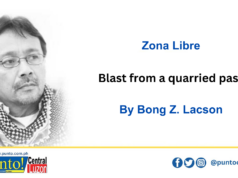THE TIPA NOVENA on August 31 marks the official start of our town fiesta celebration which culminates on September 10, the feast of San Nicolas de Tolentino, our patron saint.
Just a few days ago, my good friends and I were at the town plaza and noticed that the colorful banderitas were swaying gracefully over our heads providing some sort of a thin protective canopy from the scorching heat of the sun. Being the “sentimental fools” that we are, the mere sight of the banderitas and the welcome bamboo arch at the main entrance of the church patio signaled another trip down memory lane.
How we miss the town fiesta celebration that my friends and I experienced from the mid-70s to the early 90s! I am not even talking about the main event but the days leading to September 10. Imagine, as early as the first week of August the town plaza is slowly being turned into one grand amusement park with various rides from a carousel for the kids to a caterpillar and Ferris wheel for the more adventurous adults; different stalls that sell an assortment of toys, house fixtures, various kitchen and dining wares, and clothing items at very affordable prices; and, a bingo center with a nightly show of impersonators and musical numbers. How could I forget those tightly-guarded booths with the most striking marques enough to lure the curious children and even the most gullible not-so-young audience? I remember sneaking into that tiny showroom housing Jezabel – “ang batang ipinaglihi sa dolphin,” and even paying my way just to watch and see for myself the mystery behind Valentina – “ang kambal ahas.”
The tipa novena procession on August 31 saw the full participation of the delegates from the Macabebe East and West District public schools, together with the then lone private school in town. The elementary pupils were in their girl and boy scout uniforms, the fourth year high school students in their CAT uniforms while the female high school students wore their white veils as they recite the rosary during the entire procession. Leading the way was the late Tatang Crising Silva in his immaculate all-white attire who, even without a walkie-talkie, a headset or a mobile phone during that time, was a major force to reckon with in ensuring the smooth flow of the procession. At the end line, just before the heirloom image of Apung Kulas, were our local government leaders joined by one of our town’s most illustrious sons – Tatang Midying Bondoc, and one of Macabebe’s adopted sons – Apung Feleng Lazatin. This was the era before social media, no press coverage for “pogi points” but their sincere act of devotion to our patron saint and their humble way of saying that they were one with the people of Macabebe on this important occasion.
From September 1 to 9, the town folks were treated to nightly shows presented by the various schools and local associations. It was a visual treat to see students, teachers and school administrators perform cultural numbers. It was not a contest, but each presenting group would give it their best not wanting to shortchange their very eager audience. The fiesta night was reserved for the grand fireworks display and the jamboree, a musical extravaganza that had all the elements of the vaudeville of the 60s and the comedy acts of the modern era. If the fiesta committee had enough budget for the year, the audience would be fortunate to watch the country’s popular actors or singers perform a song-and-dance number or two. That was all it took to cap the week-long celebration – nothing really grand or fancy by today’s standards but enough to call it a memorable fiesta year, and more than enough to look forward to the next year.
After each night, we find ourselves bringing home any item we had won as a prize in any of the games, or any piece we had bought from one of the stalls at bargain prices. Sometimes it was a caldero, takuri or any kitchen item, timba, batya or tabo for the comfort room, or a set of plates or glasses that will be neatly displayed in the glass cabinet at home. As for the toys, the choices were just as endless – the kurang-kurangan set, the paper mâché horse toy, the rattle snake made from bamboo and an assortment of toys produced from the simplest of materials but were just as priceless to the kids back then.
Times have indeed changed and new priorities have been set. As we reminisce these wonderful fiesta memories and build new ones given today’s context, I just hope that we never lose sight of the significance of the fiesta celebration in our spiritual lives. May every Cabejo and Cabeja be inspired by the life of Apung Kulas, a meaningful life anchored on goodness and his deep and moving faith in the Lord.





